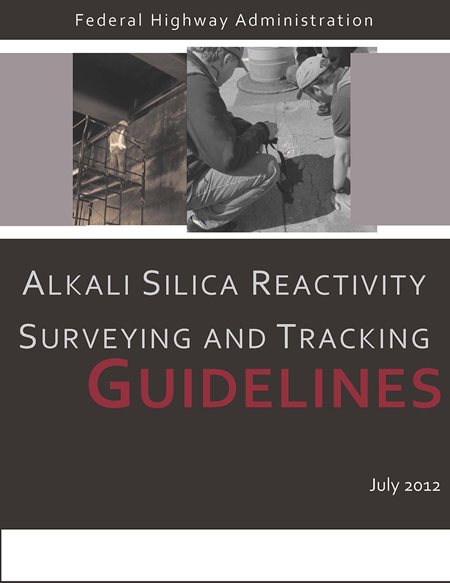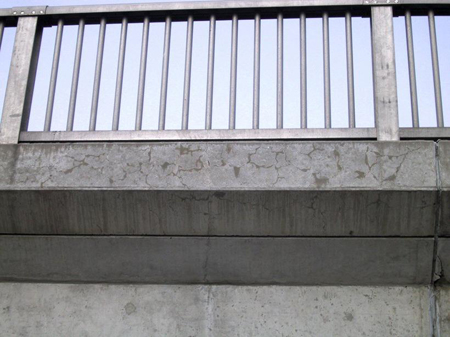U.S. Department of Transportation
Federal Highway Administration
1200 New Jersey Avenue, SE
Washington, DC 20590
202-366-4000
Focus
| Accelerating Infrastructure Innovations |
Publication Number: FHWA-HRT-13-007
Date: October 2012
Printable Version (.pdf, 03 mb)

Identify and track transportation infrastructure affected by alkali-silica reaction (ASR) with the Federal Highway Administration's (FHWA) new Alkali-Silica Reactivity Surveying and Tracking Guidelines (Pub. No. FHWA-HIF-12-046).
Dubbed STAR (Surveying and Tracking of Alkali-Aggregate Reaction), the guidelines focus on recognizing and monitoring ASR-induced expansion and cracking in bridges, pavements, and tunnels, though some of the information may also be applicable to other assets such as wharfs, piers, high-mast lights, and signs.
"These STAR guidelines provide the framework by which ASR-induced damage can be tracked with existing tools already being used by most State highway agencies, including bridge, pavement, and tunnel management systems," said Gina Ahlstrom of FHWA.
The guidelines can be used in conjunction with the FHWA Alkali-Silica Reactivity Field Identification Handbook (Pub. No. FHWA-HIF-12-022) (see August 2012 Focus). Graphically illustrating the sequence of how ASR develops, the handbook's photos provide a visual reference for identifying symptoms. To download the handbook, visit www.fhwa.dot.gov/pavement/concrete/asr/field.cfm.
ASR occurs when silica in some aggregates and alkalis in concrete combine with water to form a gel-like substance. As the gel absorbs water and expands, it can cause the concrete to crack. Over time, the cracks enable other forms of distress to occur, such as freeze-thaw damage or corrosion. This can lead to premature deterioration and loss of service life for concrete pavements and structures.
Using STAR, agencies can collect, quantify, and rank typical signs of ASR distress, based primarily on visual inspection. When a highway bridge or pavement section exhibits high values of ASR-related distress, such as cracking or joint deterioration, highway agencies can use this information to make decisions about conducting advanced studies to confirm the ASR diagnosis.
A suggested protocol is offered for integrating ASR surveying and tracking into bridge, pavement, and tunnel management programs. For example, to provide an accurate and specific tracking index, bridge management programs must include features characteristic of ASR, such as map cracking, aligned cracking, gel exudation on the concrete surface, and relative dislocation or misalignment of adjacent sections. The guidelines include photographs illustrating different severity levels for the bridge defects, along with a discussion of each defect and definitions of condition states and associated criteria.
Characteristics of ASR in pavements that should be collected by pavement management systems are identified. These include map cracking, joint deficiencies and deterioration, and longitudinal cracking. As with bridges, detailed descriptions and criteria are included for each distress type, followed by photos of the defects with varying degrees of severity.
The discussion also covers tunnel inspection and management. Tunnels are constructed primarily of concrete, steel, and masonry, with some tunnel liner types commonly composed of concrete. The inverts of tunnels -the slab on which the roadway or track bed is supported- are also generally made from concrete and could potentially be affected by ASR. The guide looks at how to integrate identification of ASR into tunnel management programs. Defects to flag as potential indicators of ASR include map cracking, aligned cracking, exudation of gel on the concrete surface, and joint expansion or dislocation.
More information on managing ASR-affected structures is available in FHWA's 2010 Report on the Diagnosis, Prognosis, and Mitigation of Alkali-Silica Reaction in Transportation Structures (Pub. No. FHWA-HIF-09-004). The report is available at www.fhwa.dot.gov/pavement/concrete/pubs/hif09004/asr00.cfm. Additional resources for both structures and pavements can be found at FHWA's online ASR Reference Center at www.fhwa.dot.gov/pavement/concrete/asr.cfm. The center contains more than 300 specifications, guidance documents, test methods, and other references on ASR.
To download the Alkali-Silica Reactivity Surveying and Tracking Guidelines, visit www.fhwa.dot.gov/pavement/pub_details.cfm?id=820. For more information on the guidelines, contact Gina Ahlstrom at FHWA, 202-366-4612 (email: gina.ahlstrom@dot.gov).

The edge beam supporting this bridge railing has minor ASR-related cracking.